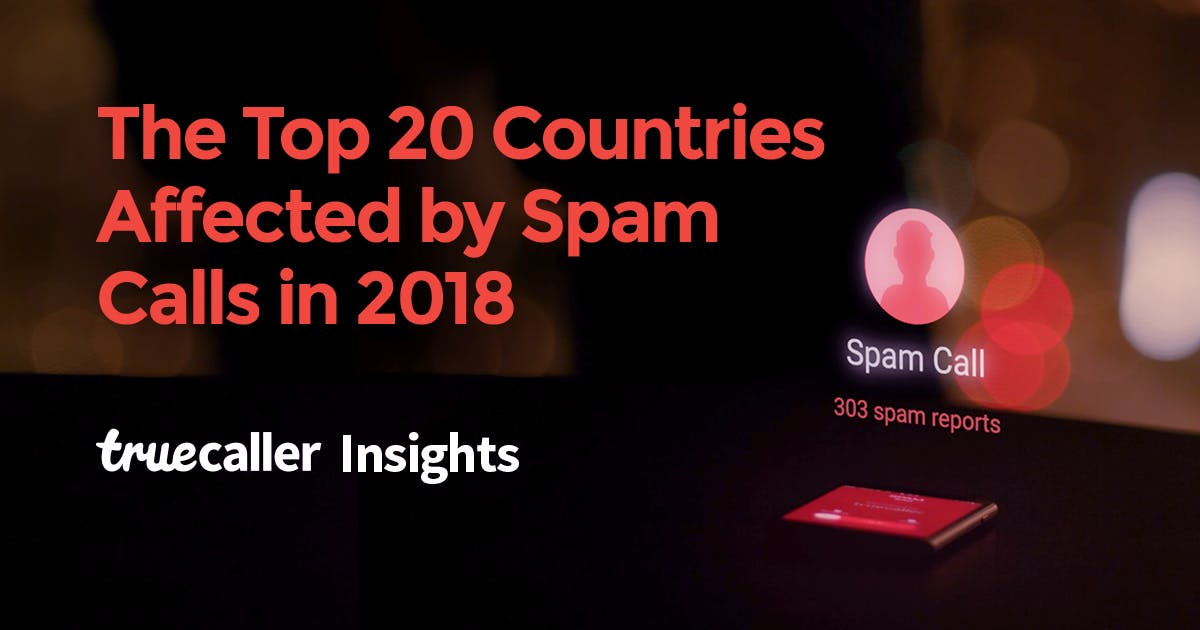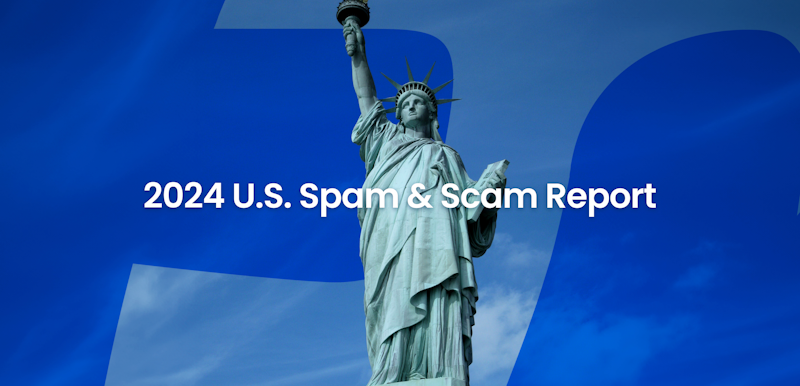
Truecaller Insights: The Top 20 Countries Affected by Spam Calls in 2018
Kim Fai Kok
Dec 18, 20188 min read
Last year we released our first Truecaller Insights on top spam-plagued countries around the world, this year we are taking a deeper look into this rising problem!
In 2018 alone, we have helped our users block and identify 17.7 billion spam calls – and we’ve helped identify 74.1 billion calls in general for our users! This means that close to every fourth call that our users receive are spam calls.
In this year’s list, shockingly, Brazil has taken over India as the most spammed country in the world, with the average Truecaller user receiving 37.5 spam calls per month. This means that Brazil has seen an 81% increase of spam calls in a year!
Here is a further breakdown of the stats:
- Although our Indian users are highly affected by spam calls there’s been a marginal decrease of spam calls in the market (1.5%.)
- An interesting trend is that USA has dropped from the 2 highest country affected by spam calls to the 8 – compared to last year. Despite the decrease of spam calls, the U.S. is still heavily affected by phone scams. 1 in every 10 American adults (10%) lost money from a phone scam in the past 12 months. With an average loss of 57 per victim, the result of these scams is projected to have cost 24.9 million Americans approximately .9 billion in total losses. Read more here: https://blog.truecaller.com/2018/04/26/truecaller-insights-usa-2018/
- New markets to enter the list: Spain, Canada, Costa Rica, Poland, Dominican Republic, and Israel.
- There’s been a big increase of spam calls in European markets like Spain (100%), Greece (54.1%) and Italy (22.7%.) However, Turkey has seen a decrease of spam calls (18%.)
- Compared to last year fewer African markets are in the Top 20 list: Kenya, Morocco, Egypt, and Nigeria. South Africa is the only country in the list – as a matter of fact the amount of spam calls has increased from 15 to 21 spam calls/months – that is a 40% increase!
- Biggest trend: a lot of Latin American countries has entered the top spam list, and these countries are seeing the biggest increase of spam calls. Costa Rica being the country that has seen the highest increase in terms of percentage (330%.)
Digging deeper into the bigger markets, we found common categories that tie all these spam calls together. The biggest pattern we could see was that operators across the world are the biggest spammers. We could also see that telemarketing calls from financial services, debt collectors and insurance related matters are spamming our users globally.
Brazil
The biggest shift in this year’s report has been that Brazil has taken over India as the most spammed country in the world.
Telemarketing calls has skyrocketed the past year in the country, compared to last year these types of calls only made up of 12% of the top spammers, this year however, it has gone up to 36%. With the general election taking place we’ve seen a surge of complaints from our users.
The operators were the biggest spammers in Brazil last year (33%) and continues to be a top spammer in the country (32%). These calls are typically seeking to provide special offers for free data, or unlimited calls.
The most alarming trend we see in this chart is that there has been an influx of scams calls – increasing from 1% (last year) to 20% this year! Typical scams includes; fraudsters pretending to collect money for illegitimate reasons for instance someone calls you up and tell you that your electricity is about to be shut off – in order for you to keep the lights on you need to wire money right away; another trending scam is the one ring scam, an unknown number (usually an international number) gives you a missed call and when you call them back you get charged a hefty fee for calling to that number
Another major spam call problem that the Brazilian are dealing with are nuisance calls (10%.) These are more general types of calls that are unwanted and unsolicited that are a disturbance for users, or at the very least, amount to prank calls and at worst, harassment and fake kidnap calls.
India
Although volume wise India receives the most spam calls in the world, the average spam call received per users has marginally dropped with 1.5% compared to last year.
Looking into this year’s breakdown of call categorization in India there has been a substantial increase of spam calls coming from operators/telecom service providers upselling various offers and balance reminders. Also, it seems like scam calls has more than doubled compared to last year – from 3% to 7%, which is very alarming!
Chile
Over the past 12 months, Chile has surfaced to become the third most spammed country in the world, and the second in Latin America.
Operators (29%) are the biggest spammers in Chile, followed by debt collection calls (25%) and financial services (23%). Then e-commerce calls (10%), nuisance (8%), telemarketing (2%), scams (2%) and insurance related spam calls (1%.)
South Africa
South Africa continues to be one of the most spammed countries in the world – where it jumps from 5 position to the 4 most spam affected country. South Africa has seen a 40% increase of spam calls in the country going from 15 to 21 spam calls/month.
Almost half (49%) of all top spam calls in South Africa is scam related e.g. tech support fraud, where someone pretends to call from your bank or a company saying that your account has been hijacked and need your help to take control of it; one ring scam, an unknown number (usually an international number) gives you a missed call and when you call them back you get charged a hefty fee for calling to that number; someone pretends to be a headhunter calling you to offer you a job but you need to pay a fee in order to get the job.
Telemarketing is also a big problem in South Africa, which accounts to 38% of all top spam calls in the country. These type of calls usally come from various companies, insurance agencies and financial services trying to offer something.
Mexico
The biggest spammers in Mexico are financial services (32%). Similar to Brazil, Mexico is also affected by nuisance (27%) and scams (19%) calls, which is not surprising.
We can also see that a big chunk of the spam calls (nearly a fifth) are political (12%) and telemarketing calls (7%) in Mexico.
U.S.
Taking a closer look at what type of spam calls that dominates in the U.S., we can see that insurance related calls have sky rocketed, from 2% to 39% in a year! Debt collecting calls has also seen a significant increase, from 7% to 33%.
Over the year there have been a lot of reporting in the media that robocalls has been a big menace and annoyance to the U.S. market – this is also shown in our data where 9% of all top spammers comes today from robocalls.
In a study that we released earlier this year we found that 1 in every 10 American adults (10%) have lost money from a phone scam in the past 12 months. With an average loss of 57 per victim, the result of these scams is projected to have cost 24.9 million Americans approximately .9 billion in total losses!
Read more here: https://blog.truecaller.com/2018/04/26/truecaller-insights-usa-2018/
Spain
This year new in the list is Spain. Compared to last year, Spain has seen a 101% increase of spam calls. Spain’s spam calling pattern is very similar to Chile where operators and debt collectors are making the most calls (over two thirds of the top spamming calls) to our users.
Debt collectors represents almost a quarter (23%) of all top spammers in Spain.
Italy
Last year Italy was the 13 most spammed country in the world, and this year it has risen to become the 11 most spammed market globally.
Telemarketing calls from energy and television providers (48%,) and operators (25%) continues to dominate as the top spammers in Italy.
Scam related calls represents 9% of the spamming calls in Italy. In the recent months, there has been a lot of reporting from the media notifying people that there has been an up rise of scam calls targeting customers of TIM, Wind Tre, and Vodafone. The scammers simply call up people with a very well thought out script to lure their victim to say ‘yes’ to their questions, which is later being cut out to be pasted to a different agreement where they seem to agree to certain premium services.
Canada
Canada is another country that has surfaced to become one of the most spammed country in the world. Last year Canada wasn’t even in the list. This year we’ve seen a 67% increase of spam calls in the country, where a lot of scam calls is taking place (over 69% of all calls!)
Debt collectors are also very active in spamming our users in Canada (12%.)
Indonesia
Indonesia is the most spammed market in the South East Asia region where our users are receiving almost ten spam calls (9.9) per month.
The top spammers in Indonesia are banks and financial services upselling various offers. There has also been a lot reporting from our users that these types of calls are scam related.
The UK
Compared to last year, telemarketing calls (last year: 31%) was a big proportion of the top spammers in the UK, this year however, we’ve seen that the telemarketing calls are more specified to PPI/insurance calls (30%), something that has been a big annoyance in the country, which the media often highlights as an issue.
This year debt collectors have clearly risen to become one of the biggest spammers in the UK (18%). Last year it was difficult to pinpoint specifically if telemarketing calls was of debt collecting nature, however this year we can see clear indication of it.
And probably the most alarming finding of this graph is that scam calls has doubled in the past year – from 8% last year to 16% this year!
The data in this article was aggregated anonymously from incoming calls that either has been marked as spam by users – or automatically been flagged by Truecaller during the period of January 1st, 2018 to October 30th, 2018 (and our previous study from last year: here) to understand the monthly average spam rate. During this period of time our users received 17.69 billion spam calls.
https://www.dropbox.com/sh/51cmeh3v6uvbh2x/AADkp_oUp659OeRVOYESiNmEa?dl=0
Nuisance: Due to this being a broad spectrum of calls, it is generally calls that is unwanted, disturbance for users, harassment, pranks.
Telemarketing: Promotional calls from companies, surveys, political/robo calls, new client outreach for services, subscriptions, etc.
Operator: Telecom companies upselling data plans, promotions, etc.
Financial service: Banks, credit unions, credit card companies etc.
Scam: Fraud attempts, money swindling, unknown links, etc.
Insurance: Companies that specialize in selling different types of insurances.
Debt collection: Organizations that specialize in payments of debts owed by individuals or businesses, bounty hunters.
Political: Campaign calls to secure votes for parties, robocalls.
Health: Hospitals, private practices.

Kim Fai Kok
Dec 18, 20188 min read


